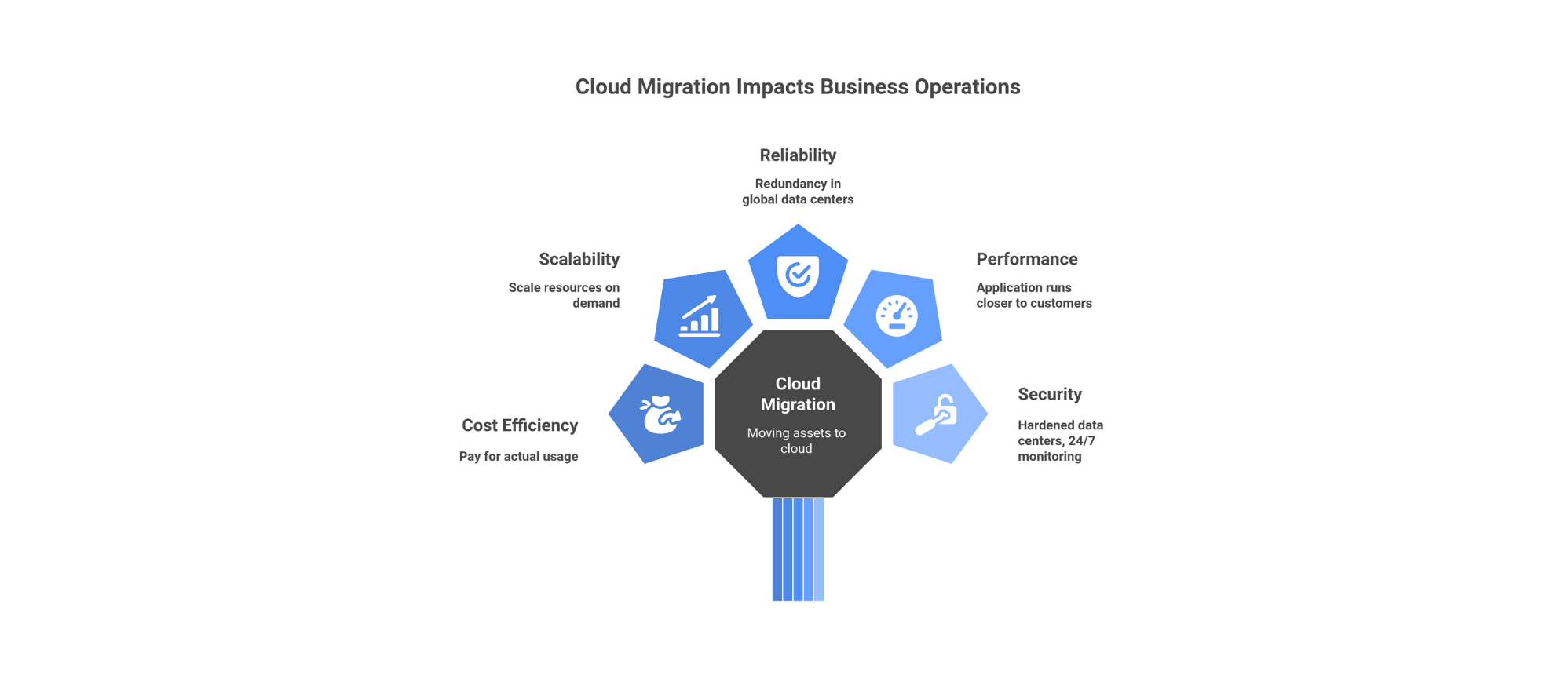Cloud Migration Strategy Blueprint: Trends, Risks, and Optimization

What is Cloud migration?
Cloud migration is the process of moving digital assets - such as data, applications, and IT infrastructure - from on-premises or traditional data centers to cloud-based environments provided by third-party service providers or from one cloud platform to another.
However, looking beyond this standard definition, cloud migration can be seen as a pivotal transformation that not only shifts operational resources but fundamentally changes how organizations architect, manage, and evolve their IT ecosystems.
Cloud migration is a technical transfer and a strategic reinvention of an organization's relationship with technology. It involves unpacking legacy methods, embracing elasticity and scalability, and adopting a mindset that values rapid innovation cycles enabled by cloud-native environments.
Migration is a series of calculated acts that harmonize an organization's specific business goals with the dynamic capabilities of modern cloud platforms, something that cannot be reduced to a one-size-fits-all movement.
There are two main types of Cloud migration.
-
On-Premise to Cloud Migration: On-premise to cloud migration involves moving applications, data, and workloads from in-house data centers to a public, private, or hybrid cloud environment. Organizations typically pursue this to reduce infrastructure costs, scale resources on demand, improve resilience, and offload the operational overhead of maintaining hardware. This type of migration often requires re-architecting legacy systems, ensuring data security during transfer, and redesigning governance models for the cloud context.
-
Cloud-to-Cloud Migration: Cloud-to-cloud migration, on the other hand, focuses on transferring digital assets between different cloud providers or from one cloud service to another within the same provider. Companies typically undertake this when switching vendors to optimize costs, improve performance, or gain access to new features, unlike on-premise to cloud migrations. This type emphasizes compatibility between cloud platforms, data format consistency, and minimizing downtime during the migration process.
Benefits of Cloud Migration
When a company runs its data center, it owns all the servers, storage, and networks. That setup can be safe and familiar, but it ties you to fixed costs and slow upgrades. Cloud migration means shifting those applications and data into a cloud provider’s environment so you rent exactly the computing power you need, when you need it.
Cost Efficiency:
Instead of buying hardware years in advance, you pay only for the resources you actually use. This eliminates idle capacity and the capital expense of over-provisioning. Just as important, the cloud lets you automate cost controls - turning off unused resources at night or shifting workloads to cheaper regions - so your spending adapts in real time to actual demand.
Scalability and Flexibility:
When traffic spikes - launch day, holiday sales, sudden media attention - cloud platforms can scale out automatically within minutes. When demand drops, they scale back just as quickly, so you’re never locked into the “peak load” footprint you would need in a traditional data center. That elasticity gives product teams freedom to experiment without long procurement cycles.
Reliability with Cost Balance:
Leading providers operate multiple global data centers and build redundancy into every layer. You can design applications to survive a server, zone, or even regional outage with almost no visible disruption. Because these resiliency features are offered as managed services, you gain high availability without the cost of duplicating entire infrastructures yourself.
Performance:
Global networks of edge locations and high-speed backbone connections mean your application can run closer to customers anywhere in the world. Built-in monitoring and autoscaling keep response times steady even when usage patterns shift, so performance tuning becomes a continuous, largely automated process rather than a crisis event.
Security:
Major cloud providers invest far more in security research, patching, and compliance certifications than most single organizations can. You inherit hardened data centers, 24/7 monitoring, and advanced encryption options. The shared-responsibility model does require careful configuration, but when managed well, the baseline security is often stronger than a typical on-premise setup.
Additional Strategic Gains
-
Faster Innovation: Access to ready-made AI, analytics, and serverless tools shortens the time from idea to product.
-
Workforce Attraction: Engineers favor modern, cloud-native environments, making it easier to hire and keep top talent.
-
Business Agility: Cloud infrastructure can be cloned or moved to new regions quickly, supporting mergers, acquisitions, or rapid market entry.
Why Cloud Migration Matters
Cloud migration is important because it unlocks access to advanced, evolving cloud services that traditional data centers often cannot match in terms of agility, innovation, and total cost of ownership. It also allows organizations to decouple growth from physical infrastructure constraints, enabling new business models and faster responses to market changes. In essence, cloud migration is a foundation for future-ready businesses that wish to remain competitive in an increasingly digital and disrupted landscape.
-
Drives Business Transformation: Let's organizations rethink old processes, automate routine work, and reimagine how teams create value - from construction to healthcare.
-
Enables Rapid Innovation: Makes product launches and data analysis faster by leveraging cloud-driven tools and real-time insights, helping companies outpace competitors.
-
Optimizes Operational Costs: Cuts waste and aligns spending with actual use, often slashing infrastructure costs by double-digit percentages.
-
Boosts Agility and Resilience: Helps businesses respond to disruptions with scalable solutions and built-in disaster recovery, as seen in banking and retail cases.
-
Increases Security and Compliance: Lets organizations automate security updates and regulatory reporting, moving sensitive workloads safely into robust cloud platforms.
-
Empowers Global Collaboration: Teams can work smarter together from
anywhere, driving unified efforts in manufacturing, finance, and beyond.
Key Cloud Migration Strategies
Cloud migration is not a single act of moving servers but a strategic unbundling of your company’s technical DNA. It’s the deliberate separation of business capabilities from a private data center's physical and procedural gravity and their re-assembly inside an environment built for constant change.
Migration forces a company to examine every hidden contract - between departments, between old code modules, even between finance and IT - and decide whether each element deserves to be moved, reshaped, or retired. The strategies you often hear about are more than technical options; they are business plays, each reflecting how much risk, re-engineering, and reinvention an organization is willing to embrace.
-
Rehost (Lift and Shift): This is the pragmatic route for those who want speed and minimal disruption. Here, applications are migrated as is - like packing up everything from an old house and setting it up in a new one. It’s fast, but doesn't leverage new cloud efficiencies until further optimizations are made later.
-
Replatform (Lift and Optimize): This approach upgrades some elements to take better advantage of cloud features, such as moving to managed databases or scalable storage. Think of it as renovating a room after you move in, making things cloud-ready without a wholesale overhaul. It's a good middle ground for short-term benefit and long-term flexibility.
-
Repurchase (Replace): In this model, legacy apps are replaced with modern, often SaaS alternatives - like switching from home-cooked to meal delivery. It’s a way to escape legacy constraints, rapidly adopting best-in-class capabilities, but it can mean losing customization and familiarity.
-
Refactor (Re-architect): This is cloud migration at its most ambitious. Applications are broken down and rebuilt to fully exploit things like microservices, serverless, and automation. It’s akin to tearing down and building a new home exactly the way you want, unlocking agility and future-proofed flexibility.
-
Retain (Keep): Sometimes, the smartest move is not to migrate at all. Sensitive or tightly integrated systems are kept on-premises until organizational readiness, compliance, or technical maturity aligns. It’s a conscious wait and see, ensuring only what truly needs to move, moves.
-
Retire (Decommission): Migration is an opportunity for spring cleaning. Redundant or obsolete systems are simply shut down. Streamlining the portfolio this way reduces clutter, cost, and complexity, focusing cloud migration resources where they matter most.
How is Cloud Migration done?
Cloud migration is the process of moving an organization's data, applications, and IT resources from on-premises servers or old infrastructure to cloud-based environments. It is important because it offers agility, cost savings, scalability, and modernization opportunities, transforming how businesses operate and compete.
-
Assess the Current Setup: Understand the existing IT environment, including applications, data, and workloads. Set clear business goals for what migration should achieve.
-
Plan the Migration: Create a detailed roadmap - choose the cloud provider, decide the order in which apps move, and prepare the necessary tools and team.
-
Prepare the Environment: Optimize and sometimes update applications and data so they can run smoothly on the cloud.
-
Migrate: Transfer data and applications to the cloud, often in phases, using approaches like lift-and-shift (moving as-is) or refactoring (modifying for cloud).
-
Test and Validate: Ensure all systems work correctly in the cloud - performance, security, and integration.
-
Go Live and Monitor: Fully switch operations to the cloud environment and continuously monitor system health, cost, and security to optimize performance.
Cloud Migration Tooling & Automation
-
Use discovery tools (AWS Migration Hub, Azure Migrate) for automated asset and dependency mapping.
-
Choose replication tools (CloudEndure) for continuous data sync and minimal downtime migration.
-
Implement ETL automation for data pipeline consistency with Talend or Fivetran.
-
Adopt IaC frameworks (Terraform, Pulumi) for automated environment provisioning.
-
Build CI/CD pipelines to integrate infrastructure deployment and application releases.
-
Utilize blue-green and canary deployment automation to reduce cutover risk.
-
Design observability stacks combining logging, metrics, and tracing for holistic system visibility.
-
Select monitoring tools to correlate cross-stack telemetry.
-
Establish alerting and automated incident workflows tied to observability platforms.
Real-World Use Cases: Why Enterprises Move to the Cloud
Across industries, cloud migration has delivered transformative results.
Retail: Cloud helps retailers scale during high-demand seasons and personalize customer experiences.
Finance & Banking: Larger BFSI enterprises migrate for compliance, security, and advanced analytics.
Healthcare: Hospitals and medical networks migrate to support telemedicine and secure patient data.
Manufacturing: Smart factories rely on cloud-powered IoT, automation, and predictive maintenance.
IT & SaaS companies: Cloud-native architecture enables global scaling, rapid deployments, and reduced costs.
Next-Gen Cloud Moves:
Companies are increasingly aware that where data lives, who controls it, and under what laws it belongs are as important as cost or performance.
At the same time, the environmental cost of digital infrastructure is no longer abstract; it’s a board-level concern that changes provider selection, deployment patterns, and even code design.
On the technical side, migration strategies are leaning heavily on predictive, AI-driven decisions - what to refactor, where to re-host, when to offload to the edge - all orchestrated via governance layers and automated policy. And those firms that thought cloud meant “anywhere” are discovering that hybrid, sovereign, and multi-cloud configurations are becoming core to strategic resilience, rather than optional complexity.
-
AI-Driven Cloud Migration: Leveraging AI to automate migration processes, predict performance issues, and optimize workloads in real time rather than relying on manual steps.
-
Multi-Cloud and Hybrid Clouds: Organizations adopt multi-cloud strategies to avoid vendor lock-in, improve resilience, and tailor workloads to the best-fit cloud environments.
-
Edge Computing Integration: Processing data near its origin to reduce latency, especially vital for IoT, healthcare, and real-time applications.
-
Security as a Cloud-First Paradigm: Advanced zero-trust models and continuous compliance monitoring become standard, embedding security into every migration phase.
-
Containerization and Microservices: Cloud-native architectures continue to drive migrations, with containers enabling modular, scalable, and agile application deployment.
-
Real-Time Cloud Cost Optimization: Continuous adjustment of cloud resources to balance performance with cost efficiency using automation and AI insights.
Final thought
Cloud migration is no longer just about moving from servers to the internet. It is about building an infrastructure that is scalable and efficient to support business growth.
Cloud migration is like installing a new operating system for the entire IT function. Old processes - capacity planning, hardware procurement, release scheduling - are rewritten as code, policies, and APIs. Teams shift from managing servers to managing outcomes, measuring success in customer experience and time-to-market rather than uptime alone.

